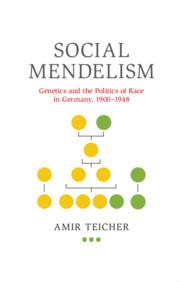Book contents
- Social Mendelism
- Social Mendelism
- Copyright page
- Dedication
- Epigraph
- Contents
- Figures
- Acknowledgments
- Abbreviations
- Introduction
- 1 Mendel’s Laws and Their Application to Humans, 1865–1913
- 2 Mendelism Maturing: From Experimental to Interpretative Framework, 1913–1933
- 3 Mendelism, Purity and National Renewal
- 4 Annihilating Defective Genes: Mendelian Consciousness and the Sterilization Campaign
- 5 Mendelizing Racial Antisemitism
- Epilogue: Social Mendelism beyond the Nazis
- Bibliography
- Index
2 - Mendelism Maturing: From Experimental to Interpretative Framework, 1913–1933
Published online by Cambridge University Press: 03 February 2020
- Social Mendelism
- Social Mendelism
- Copyright page
- Dedication
- Epigraph
- Contents
- Figures
- Acknowledgments
- Abbreviations
- Introduction
- 1 Mendel’s Laws and Their Application to Humans, 1865–1913
- 2 Mendelism Maturing: From Experimental to Interpretative Framework, 1913–1933
- 3 Mendelism, Purity and National Renewal
- 4 Annihilating Defective Genes: Mendelian Consciousness and the Sterilization Campaign
- 5 Mendelizing Racial Antisemitism
- Epilogue: Social Mendelism beyond the Nazis
- Bibliography
- Index
Summary
As it soon turned out, there was a limit to what Mendelian teaching could offer to each of these three disciplines. In the case of genealogy, adopting Mendelian assumptions required genealogists to give up too much of their traditional methods and their professional identity. They therefore adopted very little of it. Among psychiatrists, despite several vocal opponents to Mendelian inquiries, the impact of Mendelism was deep and lasting, especially in relation to schizophrenia research and to the nosology of mental illnesses. The anthropological discipline fully embraced and adapted itself to Mendelian ideas, though simultaneously recognized the limitations of Mendelian analysis. The study of skull shapes (especially cephalic index), on the one hand, and of blood types, on the other, demonstrate the spectrum of possibilities for Mendelian analysis in racial anthropology and its problematic nature. Contrary to what historians have thus far argued, at the end of the 1920s Mendelism was still a ruling paradigm both in anthropology and psychiatry, even if it no longer supplied actual tools for scientific inquiry.
Keywords
- Type
- Chapter
- Information
- Social MendelismGenetics and the Politics of Race in Germany, 1900–1948, pp. 54 - 88Publisher: Cambridge University PressPrint publication year: 2020

